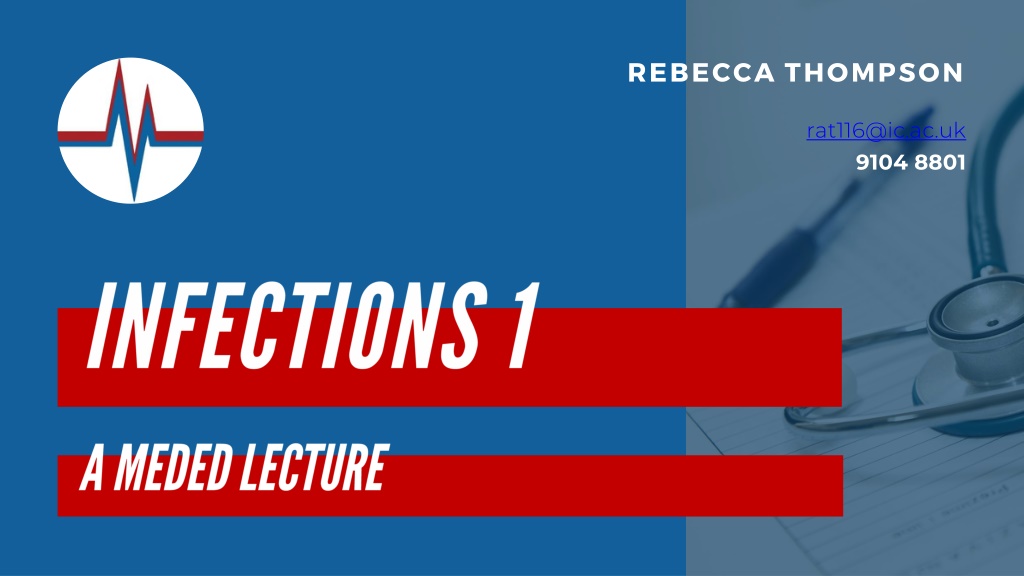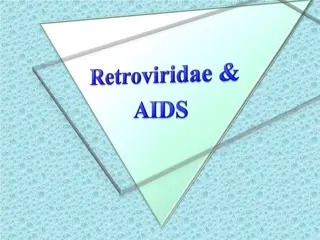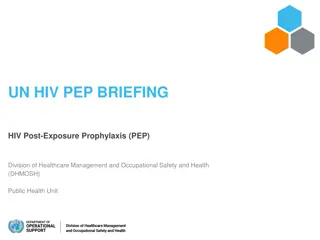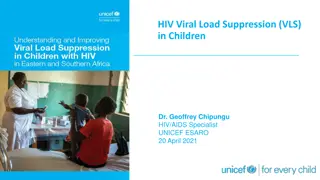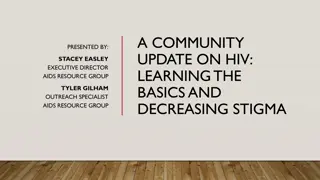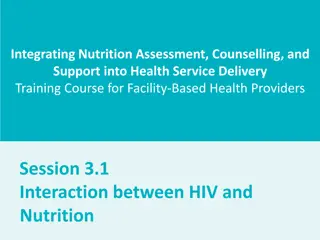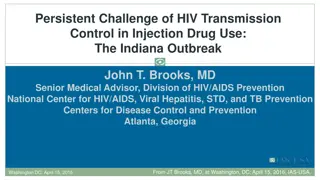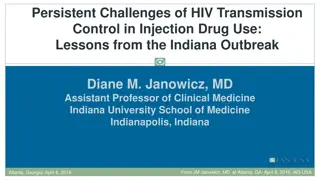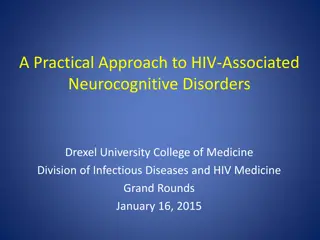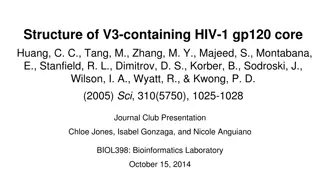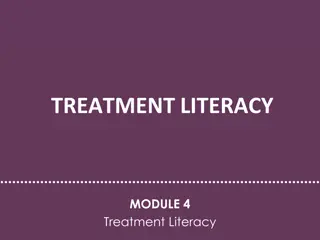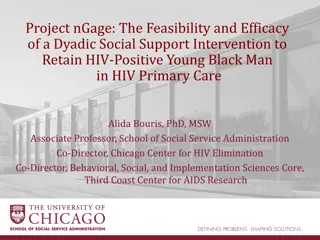Understanding HIV: Transmission, Symptoms, and Management
HIV, a single-stranded, positive-sense, enveloped RNA retrovirus, is transmitted through various means such as sexual intercourse, vertical transmission, and blood contact. The virus targets T cells, macrophages, and other immune cells, leading to acute and chronic stages with distinct symptoms. As the infection progresses, individuals may develop AIDS-defining illnesses, including neoplasms, bacterial, viral, parasitic, and fungal infections. Diagnosis involves detecting the presence of HIV genome, protein, and antibodies. Management strategies aim to control viral replication and prevent complications.
Download Presentation

Please find below an Image/Link to download the presentation.
The content on the website is provided AS IS for your information and personal use only. It may not be sold, licensed, or shared on other websites without obtaining consent from the author. Download presentation by click this link. If you encounter any issues during the download, it is possible that the publisher has removed the file from their server.
E N D
Presentation Transcript
REBECCA THOMPSON rat116@ic.ac.uk 9104 8801
Presentation Investigations Management Background Natural History
Single-stranded, positive-sense, enveloped RNA retrovirus Biological sex HIV-2 HIV-1 Transmission: West Africa, South Asia! USA, UK. worldwide! Sexual intercourse (75%) M M USA/UK M F GLOBALLY F M IVDU Vertical (M B) Placenta Breastmilk Birth canal Needlestick, Blood transfusion etc.
CXCR4 co-receptor: T cells CD4 receptor: Macrophages T-helper cells Dendritic cells CCR5 co-receptor: T cells Macrophages Monocytes Dendritic cells
ACUTE Virus: Increase then decline (still detectable) Symptoms: Flu-like (fever, myalgia, sore throat) CHRONIC / LATENT Virus: STABLE then STEADY INCREASE Symptoms: Asymptomatic OR Oral/vaginal candidiasis Herpes zoster TB Oral hairy leukoplakia (EBV) AIDS Virus: May INCREASE significantly Symptoms: severe immune compromise fever, weight loss, darrhoea, lymphadenopathy AIDS-defining illnesses Neuropsychiatric disease
AIDS DEFINING ILLNESSES Neoplasms Cervical cancer. Non-Hodgkin lymphoma. Kaposi sarcoma Human herpes virus 8 Widespread Tumours of skin, mucous membranes, GI tract, lymph nodes, lungs Bacterial infections pulmonary or extrapulmonary. Extra-pulmonary OR disseminated disease Mycobacterium tuberculosis Mycobacterium avium complex or Mycobacterium kansasii Pneumonia, recurrent Salmonella septicaemia, recurrent 2+ episodes in 12 months Viral infections CMV Herpes simplex, ulcer(s) Progressive multifocal leukoencephalopathy. Retinitis OR other (except liver, spleen, glands) more than 1 month/bronchitis/pneumonitis. Parasitic infections Cerebral toxoplasmosis. Cryptosporidiosis diarrhoea, Isosporiasis Atypical disseminated leishmaniasis. Reactivation of American trypanosomiasis More than 1 month More than 1 month Meningoencephalitis or myocarditis Fungal infections Pneumonia Disseminated infection Reduced exercise tolerance Oesophageal, bronchial/tracheal/pulmonary Pneumocystis pneumonia (PCP) / Pneumocystis jiroveci Candidiasis Cryptococcosis extrapulmonary Histoplasmosis disseminated/extrapulmonary. Coccidioidomycosis disseminated/extrapulmonary Penicilliosis disseminated
RNA/DNA = presence of HIV genome Antigen = presence of HIV protein Antibody = response to HIV RNA > 100,000 copies/mL IgG, IgM 15-45 days until +ve
Class Nucleoside and nucleotide reverse transcriptase inhibitors (NRTIs) Examples Tenofovir abacavir, zidovudine stavudine, Lamivudine emtricitabine Efavirenz nevirapine etravirine Raltegravir Fosamprenavir Atazanavir Darunavir lopinavir saquinavir (ritonavir) Maraviroc Enfuvirtide Non-nucleoside reverse transcriptase inhibitors (NNRTIs) Integrase inhibitors Protease inhibitors CCR5 inhibitors Fusion inhibitors START EVERYONE ON ART, REGARDLESS OF CD4 COUNT & VIRAL LOAD
A 27-year-old man comes to your clinic with gradual onset of a non-productive cough and reduced exercise tolerance. His past medical history is significant for intravenous drug use. On direct questioning, he reveals he has had numerous sexual partners (both male and female) in the last 2 years, with little to no use of contraceptives. His temperature is 38.3 C (101 F), pulse is 72/min, respirations are 24/min, and blood pressure is 120/80 mm Hg. Moderate wheezing is heard on auscultation of the lungs. Which of the following would be most useful in confirming the diagnosis? A. CD4 counts B. Liver function tests C. Smoking history D. Ziehl Neelsen stain of sputum E. Hepatitis serology
Family of double-stranded linear DNA viruses Herpes simplex virus HSV 1, 2 Varicella Zoster virus Epstein bar virus Human cytomegalovirus Human herpesvirus 6 (roseola) Human herpesvirus 8 (Kaposi s sarcoma)
HSV-1 & 2 Initial infection Retrograde movement Transmission Sexual transmission Mucosal / skin breaks Vertical transmission (M B) RF: Immunosuppression Medications HIV/AIDS Reactivation Latency Replication + anterograde movement Low level expression of viral genes
Genital herpes Disseminated Herpes labialis More severe Less severe Antivirals acyclovir, valaciclovir, famciclovir IV Oral Topical (labialis) Hospitalisation *Pregnant prophylaxis, CS
Chickenpox Children NOT immunised - Immunocompromised Transmission: Aerosolised droplets OR direct contact with lesion Shingles Timeline: Incubation 14 days Infectious 1-2 days BEFORE rash all lesions crusted Adults (>50) immunocompromised stress Timeline: Prodrome 2-4 days before rash Life cycle: Life cycle: reactivation of dormant VZV in ganglia travels down axon local skin inflammation
Meningitis, encephalitis Varicella pneumonitis *Congenital varicella syndrome More severe Less severe Antivirals acyclovir, valaciclovir, famciclovir Self-limiting Calamine lotion Paracetamol IV antivirals Oral antivirals IV IG *Pregnancy = separation, prophylaxis
Ramsay Hunt syndrome Post-herpetic neuralgia Herpes zoster ophthalmicus Dermatomal Erythemaotus maculopapular Painful vesicles More severe Less severe Antivirals acyclovir, valaciclovir, famciclovir Self-limiting Calamine lotion Paracetamol IV antivirals Oral antivirals IV IG *Pregnancy = separation, prophylaxis
A 59-year-old woman comes to the emergency department because of vertigo for the past 2 days. She also complains of ear pain, tinnitus, and altered taste perception. Physical examination shows vesicles in the auditory canal and auricle in addition to right-sided facial paralysis. Which of the following is the most likely diagnosis? A. Bell s palsy B. Dyssnergia cerebellaris myoclonia C. Trigeminal neuralgia D. Ramsay Hunt syndrome E. Herpes zoster ophthalmicus
HHV-4 Infectious mononucleosis / glandular fever aka kissing disease Primary infection +/- Sx Epithelial cells B cells Transmission: Saliva Sexual contact Latent T cell response controls infection B cells = reservoir Reactivation of resting B cells Viral shedding
Complications Primary infection Triad: Splenic rupture avoid contact sports! Fever, sore throat / pharyngitis, lymphadenopathy Lymphoma Hodgkin s, Burkitt s Unnoticed OR Mild URTI / flu- like Sx Hepatosplenomegaly
MONOSPOT LFTs FBC + BLOOD FILM Raised transaminases 50% cases +ve heterophile antibodies (IgM) +ve result = Abs cross react with sheep/horse RBCs agglutination +/- Direct viral detection: EBV DNA, EBV-specific Abs Treatment: Analgesia, anti-pyretics NOT ASPIRIN Corticosteroids if upper airway obstruction IVIG if thrombocytopaenia Lymphocytosis (50%) Atypical = large, irregular nuclei + clumped chromatin
Candidiasis / thrush = overgrowth of Candida species (C. albicans) Risk Factors: Pregnancy Young Dentures Antibiotics Steroids Chemotherapy COCP Diabetes mellitus Malnutrition Xerostomia dry mouth HIV/AIDS
Pseudomembranous = whitish plaques Scraped off erythematous base Atrophic (Denture) = red lesions, no plaques Hyperplastic = non-scrapable plaques Thick white discharge cottage cheese Vulvar itching + burning Dyspareunia Dysuria Asymptomatic OR Cotton feeling Pain/tenderness Odynophagia Decreased taste Angular cheilitis
Treatment KOH Test Microscopy Oral Topical antifungal nystatin, clotrimazole Systemic antifungal fluconazole ** NOT in pregnancy ** Vulvovaginal Uncomplicated: 150mg oral fluconazole OTC Pessaries OTC vaginal creams/ointment Complicated: 150mg Fluconazole in 2-3 doses Intravaginal boric acid OR flucytosine cream Species dependent (C. Albicans) Psoriasis, eczema vs Candida Branched pseudohyphae Candida = Hyphae Ringworm = septate hyphae
A 70-year-old man comes into the clinic due pain when he wears his dentures, which has developed over the last week. Physical examination shows erythema on his gums and white plaque on the buccal mucosa. Which is most likely to be seen on microscopic analysis of the plaque A. chain-forming cocci B. pseudopod-forming nonflagellate organisms C. septate hyphae D. acid-fast rod bacilli E. yeast-like cells and pseudohyphae
VIRAL or BACTERIAL Rhinovirus Adenovirus Group A streptococcus Respiratory syncytial virus 5-15yrs Crowded environments Winter/early spring Incomplete Abx course
BACTERIAL VIRAL Fever PAIN 1 pt each Fever last 24h Pus Attend rapidly, <3 days Inflamed tonsils (severe) No cough or coryza Low grade fever High grade fever CENTOR 1pt each Fever Tonsillar exudate Absent cough Tender anterior cervical LAD Sore throat Cough Odynophagia, Dysphagia Rhinorrhoea
ADULTS Phenoxymethylpenicillin OR Clarithromycin (penicillin allergic) OR Erythromycin (penicillin allergic + pregnant) CHILDREN = same Abx, different doses CONFIRMING DX If high risk of Rh fever, very old/young, immunosuppressed OR very severe Sx Rapid antigen Group A Strep Test (RAST) + culture if negative
Collection of pus surrounded by inflamed tissue Due to pyogenic (pus forming) bacteria Staph aureus Strep pyogenes Strep epidermidis P. aeruginosa Any site: Superficial skin, soft tissue Internal liver, lung, brain Risk Factors: Trauma Foreign body (piercing) IVDU Derm conditions
Warmth Peritonsillar Erythema Swelling Soft tissue Tenderness/pain Fluctuant mass Pilonoidal
USS MRI CT Anechoic/hypoechoic homogenous fluid collection T1 central hypointense area T2 hyperintense Central decreased attenuation Ring enhancement Treatment: USS-guided aspiration specimen culture ?Abx Incision, drainage
Risk Factors: Investigations: Aetiology: Imaging: RARE - find complications Inflammation of sinuses URTIs Allergies Teeth infection (maxillary) Tumours Adenitis NT/ NG tubes Genetic Kartagener, CF Causes: Influenza Parainfluenza Rhinoviruses Adenoviruses S. pneumoniae H. influenzae Moraxella Catarrhalis Bloods: FBC WCC often normal Swabs/sinus aspiration Gold std Bacterial CT: L maxillary sinusitis History: Management: Conservative: Steam Acute <4 weeks Subacute 1-3 months Chronic >3 months Complications: Medical: Bacterial 1. Penicillin, amoxicillin + clavulanic acid 2. Fluoroquinolones Abx Pain + pressure leaning forward Meningitis VIRAL BACTERIAL Fever Headache Voice/smell change > 10 days Cavernous sinus thrombosis + topical/oral steroids Discharge <10 days (Peri)orbital cellulitis Surgical: Open wall of sinus Chronic / recurrent ONLY Abscess
Aetiology: Investigations: Clinical Diagnosis Consider Ix/re-assessment if prolonged Risk Factors: Self-limiting viral infection Rhinoviruses (50%) Coronaviruses Parainfluenza RSV Influenza Adenoviruses Coxsackie viruses Age - <6yrs Malnutrition Comorbidity Smoking Stress Weather/season Management: Medical: Decongestant Antihistamines Antipyretics/Analgesia Dextromethorphan (cough) Conservative: Topical saline / nasal suction Fluids Rest History: NASAL SX Congestion, clear/purulent discharge, sneezing, erythema, swelling Complications: SORE THROAT COUGH Non-productive (LOW GRADE) FEVER Young children > older children, adults Asthma exacerbation Secondary bacterial infection Otitis media Sinusitis Pneumonia
A 25-year-old female comes to the emergency department because of sore throat, subjective fever, and rhinorrhea of two weeks duration. She also reports increased tiredness and a dry cough. She also adds that her symptoms has not improved over 2 weeks. On physical examination, her vital signs are within normal limits and her lungs are clear to auscultation. There is tenderness to palpation of her bilateral medial zygomatic and upper maxillary bones. Which of the following is the next best step in the management of this patient? A. Begin amoxicillin-clavulanate B. CT Head C. Begin azithromycin D. Sinus aspiration E. Begin trimethoprim-sulfamethoxazole
